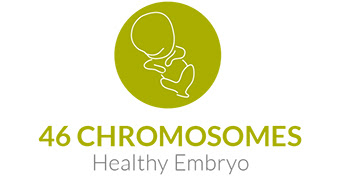The most common reason for a failed IVF is , the embryo ( s ) that are transferred to the uterus are chromosomally abnormal ( contain wrong number of chromosomes ) , and this genetic defect prevents them from implantating , and/or giving rise to a healthy baby ( since the blue print for forming a baby is defective ) . With modern scientific advancements it is possible to test whether an embryo is genetically normal or not by using techniques like Comprehensive Chromosome Screening ( CCS ). So , when a chromosomally normal embryo ( an embryo which has the correct number of chromosomes ) is transferred to the uterus , patients expect to get pregnant and carry the baby to term. But , the reality is not so.
Why does a chromosomally normal embryo fail to give rise to a healthy pregnancy ? The reasons are manifold :
1. Not all genetic testings , including CCS , are 100% accurate. They claim that the accuracy of these techniques is close to 99%.
2. Many blastocyst exhibit a phenomenon called embryonic mosaicism. During biopsy of the embryo , 5 - 10 cells from the trophoectoderm of the blastocyst ( the region which becomes future placenta ) are removed and tested for chromosomal abnormalities. Even though , the cells taken from the trophoectoderm of the embryo can have a normal chromosomal number , the inner cell mass which develops into the baby can actually carry wrong number of chromosomes. Hence , because of embryonic mosaicism , a chromosomally abnormal embryo can be labelled as chromosomally normal , and can be transferred to the uterus. Such embryos might fail to implant. Because of embryonic mosaicism there is also the danger of discarding a chromosomally normal embryo as abnormal.
2. Many blastocyst exhibit a phenomenon called embryonic mosaicism. During biopsy of the embryo , 5 - 10 cells from the trophoectoderm of the blastocyst ( the region which becomes future placenta ) are removed and tested for chromosomal abnormalities. Even though , the cells taken from the trophoectoderm of the embryo can have a normal chromosomal number , the inner cell mass which develops into the baby can actually carry wrong number of chromosomes. Hence , because of embryonic mosaicism , a chromosomally abnormal embryo can be labelled as chromosomally normal , and can be transferred to the uterus. Such embryos might fail to implant. Because of embryonic mosaicism there is also the danger of discarding a chromosomally normal embryo as abnormal.
3. Damage to the embryos during biopsy can lead to failed implantation.
4. Transfer of embryo to the uterus , and depositing them at the optimal location needs a lot of skill and expertise. When an embryo transfer was not done by a skilled doctor , the embryo might lose its chance to implant. The transferred embryo must also be retained in the optimal location. A stressful embryo transfer due cervical stenosis , or other such problems can trigger uterus contractions which can dislocate the embryo.
5. The embryo must be transferred to the endometrium when it is optimally receptive. The " window of receptivity " of an endometrium is very short. Although , most embryo transfers are optimally timed , the high amount of hormones present during fresh IVF transfer can tamper with the normal time period when an endometrium is optimally receptive ( it can become receptive too soon ! ) .This can lead to the transfer of embryo to an endometrum which is not synchronized with the embryo's age. This in turn can lead to failed implantation.
6. An embryo being chromosomslly normal does not guarantee that it is normal at the gene level. For example , humans carry approximately 20 , 000 plus genes in their chromosomes. Embryo implantation and growth involves the complex interplay of many different genes - many of which are still not identified ! Defects in such genes can prevent an embryo from implanting. We simply do not have the technology to identify them.
6. An IVF lab's embryo culture conditions , the medium used , their embryo handling and manipulation techniques can lead to failed implantation. Hence , selecting an IVF lab with good success rate is highly beneficial.
8. Mitochondria are organelles which are present in large numbers in eggs and embryos. They are the power house of cells and perform many other critical functions. They carry their own genetic material. Research shows that defect in their genetic material can prevent implantation. Older women's eggs are more prone to mitochondrial defects. We still do not have the technology to screen them.
9. Many proteins and their metabolites interplay at the site of embryo - endometrial contact to bring on a successful implantation. Defects in those molecules , or in their molecular interaction can lead to failed implantation.
9. Many proteins and their metabolites interplay at the site of embryo - endometrial contact to bring on a successful implantation. Defects in those molecules , or in their molecular interaction can lead to failed implantation.
In short , transferring a chromosomally normal embryo doesn't guarantee a pregnancy. An euploid embryo of an younger woman is more likely to implant than that of an older woman ( this indicates that there are many other factors at play other than the presence of normal number of chromosomes ) .
If you need to talk to me , please write to msnjupadmasekar@yahoo.com

No comments:
Post a Comment
Please do write to me! It makes me happy :)